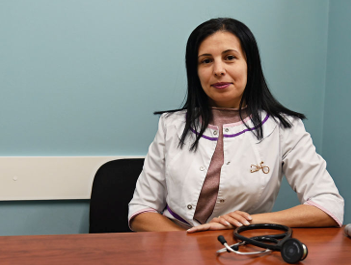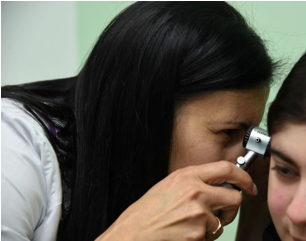Imagine that you are a 45-year-old pediatrician who has spent your life caring for children with warmth, compassion, and an unwavering commitment to their well-being. Now imagine being forced to flee your clinic and your home, abandoning the life you have so treasured, thankful just to be alive with your partner and children in a new country.
This is the reality of Dr. Margarita Hasratyan, who with hundreds of other physicians and more than 120,000 other ethnic Armenians were forced to flee Artsakh in September 2023 – literally with only the shirts on their backs. Although grateful to find safe harbor in Armenia, Dr. Hasratyan faced formidable challenges.
“After we were displaced, my family was living in a rented house, barely making ends meet. My husband and I had no income, and we had two children to support,” Dr. Hasratyan remembered.
 Dr. Hasratyan was not able to work because she lacked the credentials required by the Ministry of Health of Armenia. Fortunately, Dr. Hasratyan had connected previously with the AAHPO-Dr. Raffy Hovanessian Medical Education Program (Med Ed Program) which stood ready to assist the Artsakh physicians as they resettled in Armenia.
Dr. Hasratyan was not able to work because she lacked the credentials required by the Ministry of Health of Armenia. Fortunately, Dr. Hasratyan had connected previously with the AAHPO-Dr. Raffy Hovanessian Medical Education Program (Med Ed Program) which stood ready to assist the Artsakh physicians as they resettled in Armenia.
Because the Med Ed Program had already worked with 80% of the physicians in Artsakh, it had on file the information physicians needed to apply for credentialing. The Med Ed Program team in Armenia, led by Hambardzum Simonyan, MD, MPH, also leapt into action to provide any additional training or networking that was needed to assimilate the Artsakh physicians into the Armenian health care system. Along with assisting the physicians, the Med Ed Program helped to prevent a ‘brain-drain’ of physicians leaving Armenia to find employment elsewhere
“When crisis forced physicians from Artsakh to leave everything behind, the Med Ed Program gave them a way forward—transforming despair into resilience and safeguarding Armenia’s future in health care,” said AAHPO Board Member and distinguished medical expert Samuel Badalian, MD, PhD.
Dr. Hasratyan is just one example of the 359 physicians who, while practicing in Artsakh, received grants to travel to Yerevan for Continuing Medical Education (CME) that updated their skills and enhanced their medical knowledge, which no doubt saved lives.
Since 2023, when the physicians were forced to flee Artsakh, the program has nimbly shifted its focus from providing CME to becoming a professional lifeline for these physicians in Armenia. The Med Ed Program enabled the physicians to work and reside in Armenia.
“If it weren’t for the Med Ed Program, I wouldn’t be working right now,” said Dr. Hasratyan. “The support came at a time when we desperately needed it. Without the Med Ed Program, I truly don’t know where my family would be.” She also expressed gratitude for being enabled to provide health care to Armenian children (photo at right with patient).
 AAHPO Board Member, medical researcher and educator John P. Bilezikian, MD, PhD noted: “It is hard to imagine the reality of these physicians and their families forced to leave behind, literally at a moment’s notice, a lifetime of work and family life in Artsakh to a warmly welcoming but utterly new environment. How this transformation occurred so quickly and successfully is a testament to the ability of the AAHPO-Dr. Raffy Hovanessian Medical Education Program to make possible a brighter future for our colleagues.”
AAHPO Board Member, medical researcher and educator John P. Bilezikian, MD, PhD noted: “It is hard to imagine the reality of these physicians and their families forced to leave behind, literally at a moment’s notice, a lifetime of work and family life in Artsakh to a warmly welcoming but utterly new environment. How this transformation occurred so quickly and successfully is a testament to the ability of the AAHPO-Dr. Raffy Hovanessian Medical Education Program to make possible a brighter future for our colleagues.”
Due to the resounding success of this program and the assimilation of these physicians into the Armenian health care system, plans are under active consideration to expand the scope of their educational opportunities. These plans will be announced in November at a fundraiser for the AAHPO-Dr. Raffy Hovanessian Medical Education Program.
“We are so grateful to the late, great Dr. Raffy Hovanessian for conceiving this program that has taken on a life of its own to impact the Armenian community in ways never anticipated,” said AAHPO President Lawrence V. Najarian, MD. “It is a great collaboration of Armenian health care providers as well as donors who have supported the program for 14 years. The Med-Ed Program has exceeded all expectations.”